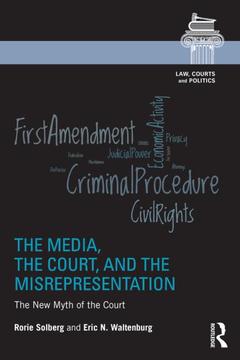The Media, the Court, and the Misrepresentation The New Myth of the Court Law, Courts and Politics Series
Auteurs : Solberg Rorie Spill, Waltenburg Eric N.

The Court?s decisions are interpreted and disseminated via the media. During this process, the media paints an image of the Court and its business. Like any artist, the media has license regarding what to cover and the amount of attention devoted to any aspect of the Court and its business. Some cases receive tremendous attention, while others languish on the back pages or are ignored. These selection effects create a skewed picture of the Court and its work, and might affect public attitudes toward the Court. Indeed, studies of media coverage of other governmental institutions reveal that when, and how, their policy decisions are covered has implications for the public?s understanding of, compliance with, support for, and cynicism about the policy.
This book uncovers and describes this coverage and compares it to the confirmation hearings, the Court?s actual work, even its members. Rorie Spill Solberg and Eric N. Waltenburg analyze media coverage of nominations and confirmation hearings, the justices? "extra-curricular" activities and their retirements/deaths, and the Court?s opinions, and compare this coverage to analyses of confirmation transcripts and the Court?s full docket. Solberg and Waltenburg contend that media now cover the Court and its personnel more similarly to its coverage of other political institutions. Journalists still regurgitate a mythology supported by the justices, a "cult of the robe," wherein unbiased and apolitical judges mechanically base their decisions upon the law and the Constitution. Furthermore, they argue the media also focus on the "cult of personality," wherein the media emphasize certain attributes of the justices and their work to match the public?s preferences for subject matter and content. The media?s portrayal, then, may undercut the Court?s legitimacy and its reservoir of good will.
1. Introduction: The Myths of the Court 2. Confirmation and the "Cult of Personality" 3. The Decisional Myth 4. The Decisional Myth, Part 2 – The Landmark Cases 5. The Personal Myth 6. Conclusion: Processing the Myths of the Court
Rorie Spill Solberg is an associate professor in the School of Public Policy at Oregon State University. She is widely published in journals such as Political Research Quarterly, Social Science Quarterly, Policy Studies Quarterly, and the Journal of Empirical Legal Studies. In 2011, she was selected to edit Judicature, the journal of the American Judicature Society. She received her PhD in American politics with a specialty in judicial politics from The Ohio State University in 1997.
Eric N. Waltenburg is an Associate Professor of Political Science at Purdue University. His research interests concern judicial politics and state politics. He has published in such journals as American Politics Research, Political Behavior, and Social Science Quarterly, and he is the author or co-author of three books on judicial politics. He is a co-editor of Politics, Groups, and Identities, the official journal of the Western Political Science Association. He received his PhD from The Ohio State University in 1994 in American Politics, with a focus on Judicial Politics.
Date de parution : 02-2015
15.2x22.9 cm
Date de parution : 12-2014
15.2x22.9 cm
Thèmes de The Media, the Court, and the Misrepresentation :
Mots-clés :
Supreme Court; Mass Media; Political Behavior and Participation; Chief Justices of the United States; Senate; Judicial Politics; NBC Nightly News; Mc Knight; Supreme Court Law Clerks; Economic Activity Category; News Peg; Internal Revenue Service; Court’s Outputs; Court’s Institutional Legitimacy; Career Life Cycles; October Term; Chief Justice Roberts’s Opinion; Justices Harry Blackmun; Partial Birth Abortion Ban Act; Supreme Court Oral Arguments; Confirmation Hearings; Justice Blackmun; Criminal Procedure Case; CBS Evening News; CBS’s Coverage; Structural Equivalent; Inattentive Reader; Total Mentions; Individual Policy Preferences; Judicial Philosophy; Landmark Cases



